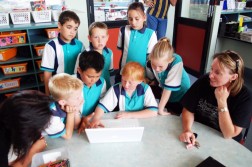Recent revelations about a NSW Christian school defrauding both the State and Commonwealth Governments won’t come as a great surprise to even casual observers of the education sector. The way we offer schooling in this country, a product of decades of ad hoc decisions, deals and various dalliances, is showing increasing signs of strain.
The first three months of this year have seen the spotlight fall on a host of education issues which both sides of politics tried to bury in the period leading up to last year’s election. The harshest spotlight was thrown by the Sydney Morning Herald‘s exclusive access to the Howard government’s secret and damning report on private school funding, which revealed that many of them are receiving more than their fair share of taxpayers’ money. New Education Minister Julia Gillard effectively denied the claims.
In February The Age weighed in with a report on potential social divisions created by faith schools, interestingly drawing on comments by Barry McGaw who is Julia Gillard’s national curriculum guru. This was followed by the SMH‘s considerable coverage of "white flight" from schools in some parts of NSW. While the extent of white flight might be debatable, it is yet another ugly side of the social separation of many of our schoolkids. But Gillard and NSW Education Minister John Della Bosca were once more in denial, preferring to restate the mantra of "choice" in schools.
When the SMH broke the story of enrolment fudging by the Lakeside Christian College secondary campus in Tweed Heads, it quoted the principal saying that the practice goes on quite a lot in private schools. He may have been attempting to deflect both attention and blame, but his claims were rather too quickly dismissed by Gillard’s office and by Della Bosca who claimed that it appeared to be a rare event. In the absence of sufficiently rigorous and frequent public auditing of private school enrolments, neither he nor Gillard would know how many schools are defrauding their respective governments.

Thanks to Fiona Katauskas
The irony is that, as private school growth rates fall, fudging the figures will become even more of a temptation. The growth rates of private secondary schools in NSW have plunged from an annual rate of 2.5 per cent five years ago to just 0.5 per cent, with public schools catching up. When you consider that most growth seems to be taking place in schools with Anglican or Islamic in the title, the others, especially Catholic schools, must be really feeling the squeeze. What else can explain promotional efforts such as the four page supplement in last Saturday’s SMH? A large number of schools established under the largesse of the Howard years remain very small and hardly viable.
For years education advocates have been raising the problems that plague our public and private schools, only to be met with distractions and diversions. While we may be emerging from years of the culture wars over schooling, there are still ample diversions to occupy our attention: the "education revolution" alone is accompanied by enough hype to eclipse the hard-to-solve problems.
So what are some of these problems?
We have a mismatch between public funding of schools and the obligations that these schools have to the public. Public schools must serve all students, while private providers are not required to assume the same range of obligations, regardless of their public funding. Some do, most don’t. Australia’s odd system of allowing schools to be both publicly and
privately funded in an unregulated way seems destined to create winners
and losers among kids and communities.
The funding of private schools is built around an entitlement principle which redefines the role of taxation and responsibility of government. The mere paying of taxes now creates an entitlement to subsidised private choice – seemingly without limit and regardless of the impact on public provision.
Next, while it seems to have bipartisan acceptance, the way we have set up school "choice" in Australia simply doesn’t work. Our system of choice favours those families with the means to pay school fees. Increasing the funding to these schools only marginally increases choice – until the fees rise again.
One of the results is that we are increasing the social class divides between schools. This is hardly surprising in a system in which some schools charge fees – they end up becoming the schools for the middle class. To some extent this will always happen, but what is worrying is that we use public funding to widen, rather than narrow, such divides. We are also increasing religious and sometimes even racial divides between schools. Is there anywhere on earth where a divided schooling system successfully builds communities and nations?
In this week as we consider the cast of 1000 who will congregate in Canberra to plan the nation’s future it is timely to recall that education is a minor summit topic, buried somewhere under economy. At the end of the summit the big education questions will remain unaddressed and certainly unresolved.
Donate To New Matilda
New Matilda is a small, independent media outlet. We survive through reader contributions, and never losing a lawsuit. If you got something from this article, giving something back helps us to continue speaking truth to power. Every little bit counts.



